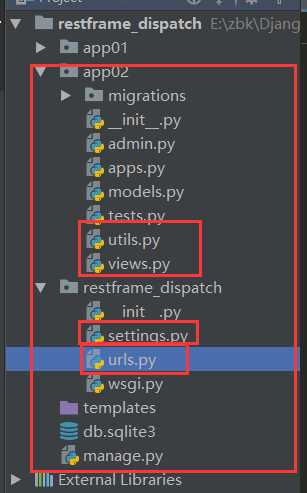framework —— permission(权限)
1.目录结构

2.urls.py:
from django.conf.urls import url from django.contrib import admin from app02 import views as app02_view urlpatterns = [ url(r‘^admin/‘, admin.site.urls), url(r‘^hosts/‘,app02_view.HostView.as_view()), url(r‘^auth/$‘,app02_view.AuthView.as_view()), url(r‘^salary/‘,app02_view.SalaryView.as_view()), url(r‘user/‘,app02_view.UserView.as_view()) ]
3.utils.py:
from django.shortcuts import render,HttpResponse from rest_framework.request import Request from rest_framework.exceptions import APIException from rest_framework.response import Response from rest_framework.authentication import BaseAuthentication from app02 import models class MyAuthentication(BaseAuthentication): def authenticate(self,request): token = request.query_params.get(‘token‘) obj = models.Userinfo.objects.filter(token=token).first() if obj: return obj(obj.username,obj) raise APIException(‘用户认证失败‘)
4.view.py:
from django.shortcuts import render,HttpResponse from rest_framework.views import APIView from rest_framework.request import Request from rest_framework.exceptions import APIException from rest_framework.response import Response from rest_framework.authentication import BaseAuthentication import time import hashlib # Create your views here. from app02 import models #认证的时候用到,生成token, 权限这快可以不需要。 class MyAuthentication(BaseAuthentication): """ All authentication classes should extend BaseAuthentication. """ def authenticate(self, request): """ Authenticate the request and return a two-tuple of (user, token). """ token = request.query_params.get(‘token‘) obj = models.Userinfo.objects.filter(token=token).first() if obj: return (obj.username,obj) return None def authenticate_header(self, request): """ Return a string to be used as the value of the `WWW-Authenticate` header in a `401 Unauthenticated` response, or `None` if the authentication scheme should return `403 Permission Denied` responses. """ pass class MyPermission(object): message = "无权访问" def has_permission(self,request,view): if request.user: # print(request.user) return True return False class AdminPermission(object): message = "无权访问" def has_permission(self,request,view): if request.user == ‘zxc‘: return True return False class AuthView(APIView): authentication_classes = [] def get(self,request): ‘‘‘ 接收用户名和密码 :param request: :return: ‘‘‘ ret ={"code":1000,"msg":None} user = request.query_params.get(‘user‘) pwd = request.query_params.get(‘pwd‘) user_obj = models.Userinfo.objects.filter(username=user,password=pwd).first() if not user_obj: ret[‘code‘] = 1001 ret[‘msg‘] = "用户名或密码错误" return Response(ret) #创建随机字符串 ctime = time.time() key = "%s|%s"%(user,pwd) m = hashlib.md5() m.update(key.encode(‘utf-8‘)) token = m.hexdigest() #保存到数据 user_obj.token = token user_obj.save() ret[‘token‘] = token # return Response(ret) class HostView(APIView): ‘‘‘ 匿名用户和管理用户都能访问 ‘‘‘ authentication_classes = [MyAuthentication,] permission_classes = [] def get(self,request,*args,**kwargs): self.dispatch # print(request.user) # print(request.auth) return Response(‘主机列表‘) class UserView(APIView): ‘‘‘ 用户能访问 ‘‘‘ authentication_classes = [MyAuthentication,] permission_classes = [MyPermission] def get(self,request,*args,**kwargs): print(‘========‘,request.user) return Response(‘用户列表‘) class SalaryView(APIView): ‘‘‘ 管理员能访问 ‘‘‘ authentication_classes = [MyAuthentication,] permission_classes = [MyPermission,AdminPermission] def get(self,request,*args,**kwargs): return Response(‘薪资列表‘)
